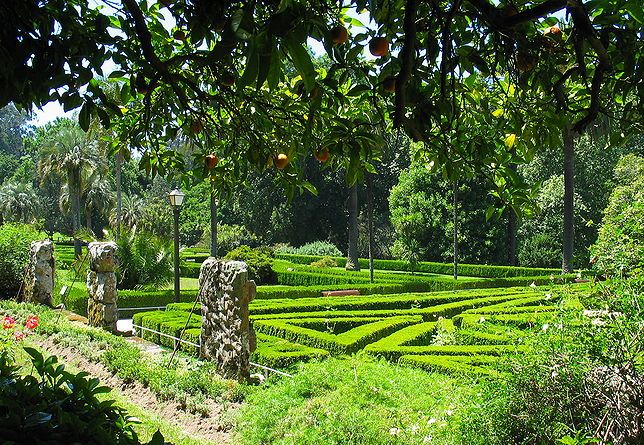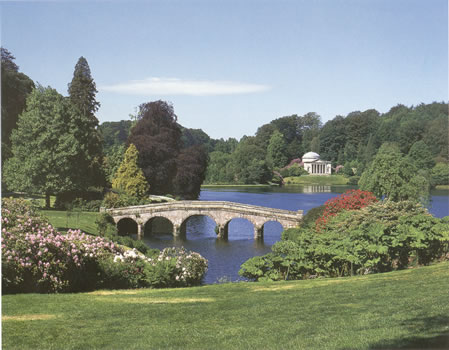The garden is the symbol of the culture of life
Gardens and farmland are more natural and more beautiful than pristine, untouched wilderness. Or at least they should be.
Of course the wilderness is beautiful. I am not trying to change anyone's view on that. But I am seeking to raise the status of cultivated land relative to it. The assumption of most conservationists today seems to be the opposite. In fact, my experience is that for many if there is an objective standard of beauty, it is nature unaffected by man.
This is consistent with a neo-pagan worldview. Many people even take this idea - that man is inferior to untouched nature - a step further and consider man not to be part of nature at all. The work of mankind is assumed to be unnatural …by nature (if you’ll forgive the phrase, but it does seem to highlight the absurdity of the position). Man's activity is seen as something that necessarily defaces creation. This places wilderness above gardens and farmland in the hierarchy of beauty; and above man in the hierarchy of being.
In the Christian worldview, man is the greatest creature in God’s creation. Man is not only part of creation, but his work can act to perfect it, that is to restore a fallen world to what it ought to be. To the degree that he works in harmony with the divine order (which is a standard higher than anything in the created world) his work is beautiful, productive and in harmony with the common good; and nature flourishes. This is the true ecology.
As soon as one acknowledges the possibility of man perfecting nature, then the route to a ‘green’ world is not the restriction of human activity, but an increase in the right sort of activity. If one seeks to change the form of human activity so that it is working beautifully, in harmony with the divine order, then the more people there are, the better.
The neo-pagan worldview, on the other hand, cannot conceive of this restorative human interaction with creation. His activity is just more or less destructive. The only solution therefore that it has to propose is the reduction of all human activity. There is only one really effective way to do this – population control.
In some ways, it is not surprising that this secular, neo-pagan world view predominates. Many would look at man’s work, especially of the last 100 years, and see destruction and ugliness. This is, it seems to me, just another reflection of modern culture, along with the art, the music, architecture and so on. And the solution is the same. The via pulchritudinis is as much the answer to the culture of death as it is the culture of ugliness.
I believe that when man cultivates the land and farms beautifully, then it is in harmony with the natural world and everything including wildlife flourishes in those parts that are left; the food produced is of a greater variety, healthier and tastier and it is produced in abundance. A discussion of farming methods is ultimately one about economics. This should be no surprise. Economics and business are a reflection of the culture as much as high art. However, this is beyond the scope of this short article. I have included, though, a picture of myself out for a walk in the Shropshire countryside in England. This landscape was formed by centuries of sympathetic farming (although one wonders how much longer it will be maintained). I could have as easily picked out a photograph of Tuscany , Provence, Granada or any small farm in New Hampshire (although these are disappearing fast).
This article is in praise of gardening. Unlike farming, there is no need to discuss economics. Anyone with the smallest plot of land can create a beautiful garden as anyone who has visited England will know (England is a land of beautiful gardens). when I talk of gardens, I am talking here of the cultivation of land for beauty, rather than for food. If farming is the Martha of man’s relationship with nature, gardening is the Mary. Adam was the first gardener in Eden. I would love to see the adoption of beautiful gardens as a modern symbol of a true ecology where man works with nature to restore Eden!
The traditional European model of the garden is geometric in form. I always imagine that the cloistered pathway into the church, should look onto the cloistered garden which is a re-creation Eden and a preparation for entering the church, which should evoke heaven. It should be the place in which man elevates the natural world, through God’s grace, into the highest and most beautiful form he is capable of producing. The picture shown above is of a cloistered garden, not in a monastery but in a stately home in Wales. Although simple (I had hoped to find something more ornate, but couldn't) it is still beautiful I think.
 The English tradition of the landscaped garden arose in the 17th century in imitation of paintings by the baroque masters of rural idylls in the neo-classical tradition. So for example we see a painting by the 17th-century French landscape painter Claude Lorrain and a garden designed by Capability Brown at Stourhead in Wiltshire, England. There is even a ‘folly’ (a building that has no utility other than its place in the view) which mimics the Roman Pantheon.
The English tradition of the landscaped garden arose in the 17th century in imitation of paintings by the baroque masters of rural idylls in the neo-classical tradition. So for example we see a painting by the 17th-century French landscape painter Claude Lorrain and a garden designed by Capability Brown at Stourhead in Wiltshire, England. There is even a ‘folly’ (a building that has no utility other than its place in the view) which mimics the Roman Pantheon.
My parents were avid gardeners who cultivated the back garden in the tradition of the English cottage garden. They are now retired and live in southern Spain (along with a host of British ex-pat retirees). Many English people recreate this style in the gardens of their villas in Malaga region. It is a year-round watering job just to keep the lawn, the tulips and petunias alive. My mum and dad, on the other hand, decided to use a similar design to their English garden, based upon foliage colours of shrubs and perennials, but by making use of indigenous species. Consequently, it thrives with a fraction of the watering. Mention this just to make the point that wherever you are, there plants that grow well and which can be ordered in a beautiful way. So you can plant your monastic cloistered cactus garden in Arizona, starting today!







